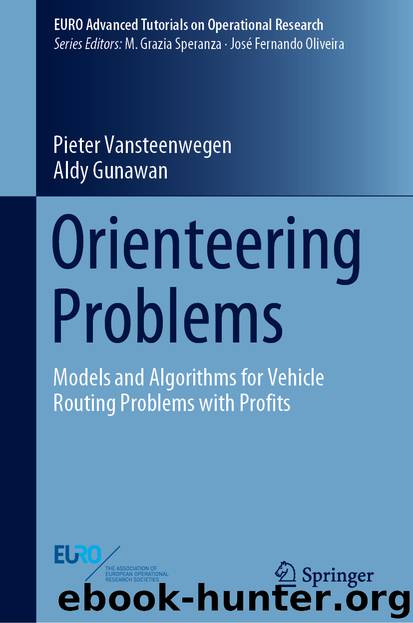Orienteering Problems by Pieter Vansteenwegen & Aldy Gunawan

Author:Pieter Vansteenwegen & Aldy Gunawan
Language: eng
Format: epub
ISBN: 9783030297466
Publisher: Springer International Publishing
5.3.3 Metaheuristics for the TOP
Various types of solution algorithms are developed for solving the TOP, such as a memetic algorithm (MA), simulated annealing (SA), particle swarm optimization (PSO) and a genetic algorithm (GA). A memetic algorithm is a combination of an evolutionary algorithm and local search (LS) techniques and it has been used for solving the VRP. In the context of the TOP, a genetic algorithm (GA) is selected as one of evolutionary algorithms. Each solution in the GA is encoded by a simple indirect encoding, namely a giant tour. The giant tour is encoded as a sequence, e.g., a permutation of all nodes. A certain number of routes (m) can then be extracted from the giant tour based on the order of the visited nodes in the sequence and the constraints. Three different moves: Shift, Swap, and Destruct-repair are used as mutation operators. Shift corresponds to the earlier explained Relocate, but now implemented on the giant tour. For each node it is checked if a better position in the giant tour can be found. In Swap, illustrated in Fig. 5.14, an exchange of all couples of two different nodes in the giant tour is evaluated. Destruct-repair is done by removing a small part of the giant tour sequence with a view to rebuilding an improved solution.
A small number of solutions in the initial population is built by an Iterative Destruction/Construction Heuristic (IDCH) and the rest is generated randomly. New chromosomes are evaluated using the Optimal Splitting procedure. The population is a set of chromosomes for which two criteria are evaluated: the profit and the total travel cost. At the end of the search, the chromosome with the highest profit is treated as the best solution.
Various population-based algorithms based on PSO have been proposed to solve the TOP. We will discuss the latest PSO, namely PSO-inspired algorithm (PSOiA). As explained in Sect. 5.3.2, PSO is a swarm intelligence algorithm with the basic idea of simulating the collective behavior of swarms in nature. Each particle in the swarm has a small probability to be relocated to a completely new position and it also has a probability to be further improved through a local search process. The concept of the giant tour and some of the above-mentioned local search moves are implemented.
Also, a combination of Simulated Annealing and a multi-start hill climbing strategy is able to solve the TOP. The multi-start hill climbing strategy is implemented in order to escape from local optima. Simulated Annealing begins with a randomly generated initial solution. At each iteration, it selects a new solution from the neighborhood of the current solution. A worse solution can be accepted with a small probability. Local search moves, such as swap and insert, are implemented in order to further improve the quality of the solution.
The last algorithm, Guided Local Search (GLS), combines different local search moves to solve both the OP and the TOP. First, all nodes that cannot be reached anyway are removed from the instance. Then, each route is assigned to one of the nodes which are furthest from the start and end nodes.
Download
This site does not store any files on its server. We only index and link to content provided by other sites. Please contact the content providers to delete copyright contents if any and email us, we'll remove relevant links or contents immediately.
| Algebra | Calculus |
| Combinatorics | Discrete Mathematics |
| Finite Mathematics | Fractals |
| Functional Analysis | Group Theory |
| Logic | Number Theory |
| Set Theory |
Modelling of Convective Heat and Mass Transfer in Rotating Flows by Igor V. Shevchuk(6406)
Weapons of Math Destruction by Cathy O'Neil(6214)
Factfulness: Ten Reasons We're Wrong About the World – and Why Things Are Better Than You Think by Hans Rosling(4713)
A Mind For Numbers: How to Excel at Math and Science (Even If You Flunked Algebra) by Barbara Oakley(3256)
Descartes' Error by Antonio Damasio(3247)
Factfulness_Ten Reasons We're Wrong About the World_and Why Things Are Better Than You Think by Hans Rosling(3216)
TCP IP by Todd Lammle(3154)
Fooled by Randomness: The Hidden Role of Chance in Life and in the Markets by Nassim Nicholas Taleb(3080)
Applied Predictive Modeling by Max Kuhn & Kjell Johnson(3041)
The Tyranny of Metrics by Jerry Z. Muller(3028)
The Book of Numbers by Peter Bentley(2928)
The Great Unknown by Marcus du Sautoy(2662)
Once Upon an Algorithm by Martin Erwig(2621)
Easy Algebra Step-by-Step by Sandra Luna McCune(2603)
Lady Luck by Kristen Ashley(2553)
Police Exams Prep 2018-2019 by Kaplan Test Prep(2516)
Practical Guide To Principal Component Methods in R (Multivariate Analysis Book 2) by Alboukadel Kassambara(2512)
All Things Reconsidered by Bill Thompson III(2370)
Linear Time-Invariant Systems, Behaviors and Modules by Ulrich Oberst & Martin Scheicher & Ingrid Scheicher(2346)
